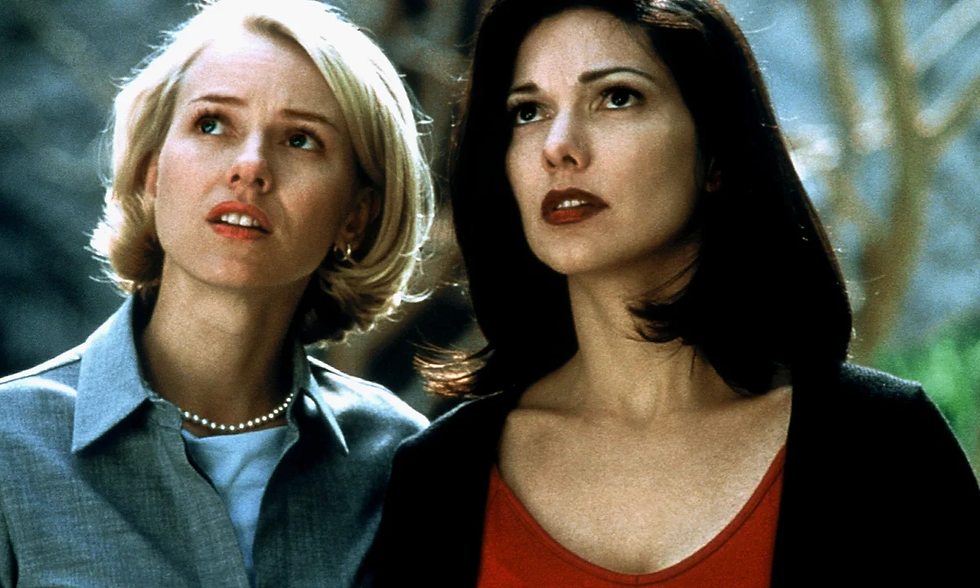David Lynch’s American Nightmare: A Mulholland Drive Movie Night Post-Mortem
- Aida Kasparova
- 1 day ago
- 3 min read
It was the inaugural Sunday of a weekly dorm floor movie night, and for some reason, unbeknownst to me still, my friend and I had settled on watching David Lynch’s 2001 film Mulholland Drive. Perhaps it was a sentiment of reminiscence catalyzed by David Lynch’s passing earlier this year, perhaps the fact that Mulholland Drive earned impressive second place on the New York Times Best Movies of the 21st Century List. One thing was for sure, however: it was an unforgettable first movie night, for better or for worse.
Like many classic Lynchian films—which often feature surreal elements juxtaposed with ordinary settings—Mulholland Drive defies explanation or expectation. A simple synopsis would be that the film follows new Hollywood arrival, Betty Elms (Naomi Watts), as she tries to help an amnesiac actress who temporarily adopts the name Rita (Laura Harring). The damsels-in-distress attempt to solve this noir mystery–and fall in love along the way–all while director Alan Kesher (Justin Thoreux) is forced by the mob to cast an actress in his upcoming movie. There is also an ominous cowboy, a botched assassination which implicates an innocent janitor, a visit to the club Silencio, where all the performances are pre-recorded, and a casting audition gone perverse.

Indeed, this description does not do justice to the truly wild, surreal ride the film takes you on. Lynch is a master of unsettling the viewer through subtle details, a craft seen on full display in Mulholland Drive. Off-putting, overly wooden performances which show progressive glimpses of emotion; sequences that drag on for a tad longer than they should; a recurring theme consisting of haunting strings; symbols whose specificity signals intentionality but whose meaning remains obfuscated. There is one phrase that sums up Mulholland Drive: uncanny valley. In light of all these details, the crowd reaction should come to no surprise–there were covered eyes, groans of confusion, general shock, and screams. The tepid question that hung in the air while the credits rolled was okay, but what did it all mean?
Prior to this watching, I had seen Mulholland Drive on my own. I enjoyed the film, and even more the task of piecing it all together. While it lends itself to a host of interpretations—only bolstered by the fact that David Lynch refused to offer any concrete explanation—Mulholland Drive’s third act does provide a general framework for understanding the film. Mulholland Drive is, first and foremost, a film about dreams and the heartbreaking breakdown that occurs when reality fails to coincide with them. It is why the film is set in a Lynchian favorite, Hollywood: the main factory of the American Dream, selling a silver-screened promise that it will never keep.
Yet rewatching Mulholland Drive with a group on a late Sunday night crystallized to me a truth about the film. It made me want to step away from the methodical approach of uncovering the intentionality behind every symbol. Instead, I left thinking and its purpose as a film in Mulholland Drive. On this magical collective viewing of Mulholland Drive, what stood out to me was that—despite the confusion—everyone was experiencing intense emotions for each beat. People audibly gasped or screamed when a tense buildup resulted in a monstrous figure stepping from behind a wall. There was joy when Betty and Rita shared an intimate moment together. Laughing erupted constantly–when Alan Kesher unemotionally poured paint over his cheating wife’s jewelry to Rita’s lost and dejected delivery of “donde estas?” (The latter line still echoes in our minds.)

Indeed, Mulholland Drive’s symbols, sequences, and subjects might be unexplainable, but that confusion does not create apathy or disinterest: it births visceral reactions instead. The film’s unsettling and even horrific nature is not due to confusion, but because it robs us of our ability to vocalize what we are watching. Society operates in part because we are willing to imbue symbols, experiences, places, and events with a set of collectively agreed-upon meanings. But Mulholland Drive takes the glittering Hollywood sign and turns it into the center of a corrupt city; a cozy American diner, the setting of a hit job; a regular casting call turning uncomfortably sexual. This is the essence of Mulholland Drive and David Lynch’s critique of the American Dream: disrupting our language of reality so that we are left with nothing but our base emotions. Thus, we are left with no choice but to experience this nightmare together.
Aida Kasparova is a freshman at Columbia College studying History and Russian Culture and Literature. In her spare time, she enjoys writing about a variety of subjects, most of all film.
